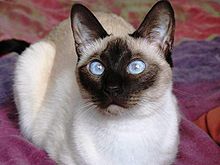|
Siamese Cats
Siamese Cats are one of the first distinctly recognized breeds of an Oriental cat. The exact origins of the breed are unknown. It is believed to be from Southeast Asia and said to be descended from the sacred temple cats of Siam (now Thailand).
Their Thai name is Wichien Maat. In Thailand, where they are one of several native breeds, they are called Wichien-maat a name meaning ("Moon Diamond").
In the twentieth century the Siamese cat became one of the most popular breeds in Europe and North America. Typically Siamese cats are long-lived, 15-20 years is average and over 20 is not uncommon.
History
The pointed cat known in the West as "Siamese" is one of several breeds of cats from Siam described and illustrated in manuscripts called "Tamra Maew" (Cat Poems), estimated to have been written in the 1700s.
As the story goes, the breed first was seen outside their Asian home in 1884, when the British Counsul-General in Bangkok, Edward Blencowe Gould (1847-1916), brought a breeding pair of the cats, Pho and Mia, back to Britain as a gift for his sister, Miss Lilian Gould ( later Mrs. Lilian Jane Veley) (who went on to be co-founder of the Siamese Cat Club in 1901).
In 1885, Veley's UK cats Pho and Mia produced three Siamese kittens. The kittens – Duen Ngai, Kalohom, and Khromata – and their parents were shown at the Crystal Palace Show in 1885, where they made a huge impression because of their unique appearance and distinct behavior.
Unfortunately, all three of the kittens died soon after the show. The reason for their deaths is not documented, but may have been distemper according to some accounts.
The year 1878, U.S. President Rutherford B. Hayes received "Siam", a gift from the American Consul in Bangkok. This cat was also the first documented Siamese to reach the United Statse and predates the Siamese's arrival in the UK by 6 years.
In 1886, another pair (with kittens) were imported to the UK by a Mrs. Vyvyan and her sister. Compared to the British Shorthair and Persian cats that were familiar to most Britons, these Siamese imports were longer and less "cobby" in body types, had heads that were less round with wedge-shaped muzzles and had larger ears.
These differences and the pointed coat pattern which had not been seen before by Westerners, produced a strong impression--one early viewer described them as "an unnatural nightmare of a cat".
These striking cats won some devoted fans.Over the next several years fanciers imported a small number of cats, which together formed the base breeding pool for the entire breed in Great Britain. Belief is most Siamese in Britain today are descended from about eleven of these original imports.
Several sources give Gould's brother Owen Nutcombe Gould as the British Consul-General in Bangkok, but Owen was only 27 in 1884 and not known to be in Bangkok.
In their early days in Britain they were called the "Royal Cat of Siam", reflecting reports that they had previously been kept only by Siamese royalty. Later research has not shown evidence of any organized royal breeding program in Siam.
The original Siamese imports were, as like their descendants in Thailand today, medium-sized, rather long-bodied, muscular, graceful cats with moderately wedge-shaped heads and ears.
They were comparatively large but in proportion to the size of the head. The cats ranged from rather substantial to rather slender but were not extreme in either way.
Appearance
The breed standard of the Modern Siamese indicates an elegant, slim, stylish, flexible and well muscled body. The cats head is triangular shaped, with a thin snout. The eyes are almond-shaped and oblique, the ears large and thin.
It has a long neck, body and tail. The fur is short, glossy, fine, soft, tight and adhered to the body. The Siamese is characterized by their typical pointed color scheme.
Originally the vast majority of Siamese cats had seal (extremely dark brown, almost black) points, but occasionally Siamese were born with blue (a cool gray) points, genetically a dilution of seal point; chocolate (lighter brown) points, a genetic variation of seal point or lilac (pale warm gray) points, genetically a diluted chocolate.
These colors were at first considered "inferior" seal points and were not qualified for showing or breeding. The Thai or Traditional Siamese shares some features with the Modern Siamese ( the color pattern) but differs from it by their rounded shapes.
These cats have a more compact body and an applehead, with full and rounded cheeks, shorter snout, ears high, but not huge. The eyes are medium to slightly large, a very full almond shape, but not oriental.
In Conclusion Siamese cats are quite unique and largely different from other breeds of cats. These fine felines have their very own distinctive characteristics, behavioural patterns and specific requirements. Many experts are said to say they believe the Siamese actually behave more like dogs than cats.
Because the Siamese is genetically and physiologically different from other cat breeds, it make sense to properly understand and care for them by giving them specialized information they need. Abyssinian Cat
|





